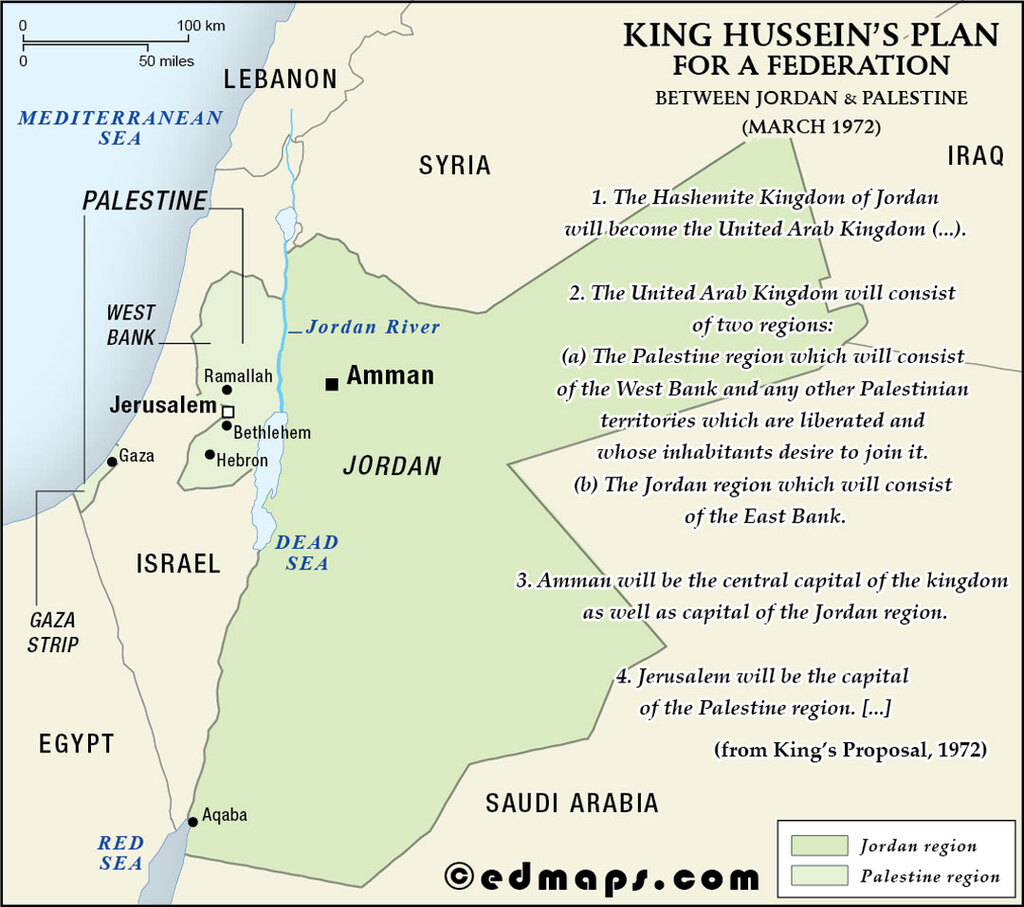
On March 15, 1972, King Hussein of Jordan proposed the United Arab Kingdom, a federation of two autonomous regions: the Jordan region (East Bank) and the Palestine region (West Bank and any liberated Palestinian territories). Amman would serve as the central and Jordanian capital, while Jerusalem would be the Palestinian capital. The plan envisioned a single army and centralized military, foreign affairs, and security under a central government in Amman, with each region having equal representation in a National Assembly. The proposal required Israel’s withdrawal from the West Bank, including East Jerusalem, but was rejected by Israel, the PLO, and most Arab states.

King Hussein of Jordan's March 15, 1972 proposal for a United Arab Kingdom represented one of the most ambitious and detailed attempts to resolve the Palestinian question through a federal solution. Coming just five years after Jordan's devastating loss of the West Bank in the 1967 Six-Day War, Hussein's plan offered a sophisticated alternative to both continued Israeli occupation and the increasingly radical demands of Palestinian nationalist movements. His proposal sought to balance Palestinian aspirations for self-governance with Jordanian security concerns and regional stability.
The United Arab Kingdom concept envisioned a federal state comprising two autonomous regions: the Jordan region encompassing the East Bank territories, and the Palestine region including the West Bank and any future liberated Palestinian territories. This structure represented Hussein's attempt to accommodate Palestinian national identity while maintaining Jordanian influence over the broader political framework. The plan's federal architecture reflected lessons learned from other successful multinational states, proposing a system that could theoretically satisfy both peoples' desire for self-determination.
Central to Hussein's vision was the symbolic and practical division of capitals. While Amman would serve as both the central federal capital and the Jordanian regional capital, Jerusalem would function as the Palestinian capital. This arrangement acknowledged the deep emotional and religious significance of Jerusalem to Palestinian identity while ensuring that overall federal authority remained centered in Jordan. The proposal implicitly recognized Palestinian claims to East Jerusalem, which had been under Jordanian control from 1948 to 1967.
The federal structure Hussein proposed was carefully designed to balance autonomy with unity. Each region would enjoy equal representation in a National Assembly, suggesting a democratic foundation for the federation despite the significant population disparities between the two regions. However, crucial sovereign functions—military affairs, foreign policy, and security—would remain centralized under federal control based in Amman. This arrangement reflected Hussein's understanding that Jordan's survival depended on maintaining control over strategic decision-making while offering Palestinians meaningful self-governance in domestic affairs.
The plan's most challenging requirement was Israel's complete withdrawal from the West Bank, including East Jerusalem. Hussein recognized that without territorial concessions, any federal arrangement would remain purely theoretical. His proposal essentially demanded a return to pre-1967 borders as a prerequisite for the new federation, making Israeli cooperation essential but unlikely given the strategic value Israel placed on these territories.
The United Arab Kingdom proposal faced immediate and comprehensive rejection from all major stakeholders. Israel refused to consider withdrawal from territories it viewed as strategically vital. The Palestine Liberation Organization, then gaining international recognition, rejected any solution that did not lead to independent Palestinian statehood. Most Arab states also opposed the plan, viewing it as a betrayal of Palestinian rights and an attempt by Jordan to reassert control over Palestinian national aspirations.
Hussein's 1972 proposal ultimately demonstrated the complexity of finding middle-ground solutions in a conflict increasingly defined by maximalist positions and mutual mistrust.